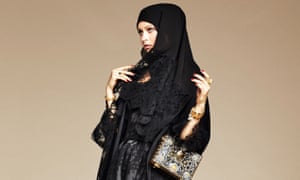
Last week, Dolce & Gabbana released its first hijab and abaya collection[1] for Muslim women in the Middle East. Catering to the Islamic requirements of loose-fitting clothing, the collection featured flowing, full-length dresses with long sleeves as well as headscarves – a striking image from a global fashion brand at a time where suspicion and hatred of Muslims is on the rise.
D&G is the latest of several major fashion labels to have recently created clothing for Muslims. DKNY, Tommy Hilfiger and Oscar de la Renta have also produced a clothing line targeting the Muslim market, while H&M featured a hijab-wearing model[2] in one of its 2015 advert campaigns.
Across social media, I have watched Muslim women around the world falling over themselves to celebrate the release of these Muslim-friendly collections. Though many saw it as a cultural breakthrough, I couldn't help but take a more cynical position. Sales of luxury goods in the Middle East hit $8.7bn[3] last year, and Muslims worldwide spent $266bn[4] on luxury goods in 2013, it becomes clear what truly motivates these brands in their production of "modest" clothing.
Perhaps we should remember that Dolce & Gabbana is the same brand that released a collection in 2012 featuring white models wearing black women's faces as earrings[6] and clothes, inspired by the racist depictions of black Moors in the 13th-century Sicilian Opera dei Pupi[7]. Given this, I'm reluctant to believe that only a few years later they suddenly care about accommodating a maligned ethnic community.
As a Muslim woman and the intended target consumer, I thought that the pale white model wearing the clothing served as yet another stark reminder that eastern culture may only be celebrated when it is glamorised by western society, which can in turn capitalise on it. In the context of global Islamophobia, there is something that makes me feel quite uneasy seeing a towering white woman praised for looking glamorous in the same clothing that often leaves Muslim women perceived as "extremist" and puts them at risk of being attacked or even criminalised in some western societies[8].
This range rather looks like an appropriation of existing traditions without giving them any real recognition. The fashion industry has been hugely successful in Muslim countries for many years now, and Muslim women around the globe have been extremely inventive in creating fashionable looks that allow high fashion clothing to conform to guidelines of Islamic dress. Muslim women often seek inspiration from countless fashion blogs and social media dedicated to presenting modest yet stylish outfits.
D&G seems to recognise Muslim fashion, and want to profit from it too. But as the prominent British Muslim fashion blogger and designer Dina Torkia recently wrote[10], "I dreamed of being included in the mainstream of haute couture, & whilst D&G have managed to recognise us with this collection, they've also managed to exclude us."
It is difficult for me to feel excited and grateful for a fashion line that supposedly caters to me and the requirements of my faith, when it feels as though the overwhelming message is that the only desirable Muslim is a wealthy one; that Muslim fashion is acceptable, but only when legitimised by a major western fashion label. And that ultimately western society will always have the monopoly on what is fashionable and relevant.
References
- ^ hijab and abaya collection (www.theguardian.com)
- ^ a hijab-wearing model (www.theguardian.com)
- ^ $8.7bn (www.forbes.com)
- ^ $266bn (www.cbc.ca)
- ^ Dolce & Gabbana launches luxury hijab collection (www.theguardian.com)
- ^ black women's faces as earrings (jezebel.com)
- ^ Opera dei Pupi (www.unesco.org)
- ^ at risk of being attacked or even criminalised in some western societies (www.theguardian.com)
- ^ How the hijab – and H&M – are reshaping mainstream British culture | Remona Aly (www.theguardian.com)
- ^ Dina Torkia recently wrote (www.dinatorkia.co.uk)










